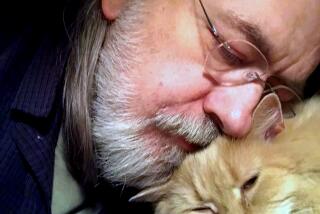A welcome reunion with an old friend
- Share via
The tales of Sherlock Holmes have spawned more pastiches (from the Italian pasticcio, originally a pastry that was a medley of flavors, now meaning a work composed in an imitative style) than any other written work. At last count (and Sherlockians have counted these things), the list numbers well over 4,000. Among the earliest and most highly regarded were those produced by the mystery/horror writer and publisher August Derleth, whose series of 70 stories about the Edwardian detective Solar Pons and his chronicler Dr. Lyndon Parker appeared from 1928 to 1971. These well-written adventures not only earned their own fan club (the Praed Street Irregulars) and journal (The Pontine Dossier) but also, after Derleth’s death, a series of pastiches of the pastiches written by Basil Copper.
Nicholas Meyer, author of three pastiches, including the highly influential and successful “The Seven-Per-Cent Solution” in 1974, pondered the urge to write them in a 1998 essay. In writing pastiche, he observed, the artist “is measuring himself or herself against the gold standard of the original, or at least the previous.... We should all write Holmes pastiches. [By doing so] we each challenge ourselves to take the restrictions imposed upon us by Doyle and see what aspects of ourselves can be brought to light by such a transfusion.”
Not surprisingly, the countless imitations include countless bad imitations. One of the sorrier tendencies has been to draw other well-known Victorian and Edwardian figures into Holmes’ universe, perhaps in an effort to add verisimilitude. Meyer introduced Sigmund Freud; others have boldly included Karl Marx, Theodore Roosevelt, Oscar Wilde, Lily Langtry, Sarah Bernhardt, Aleister Crowley, Jack the Ripper and other notables of the age. So too has Holmes met Count Dracula, Dr. Jekyll, Lord Greystoke and other inhabitants of Victorian fiction.
Caleb Carr’s latest novel, “The Italian Secretary,” an unabashed pastiche of Sherlock Holmes, is markedly different from his two mysteries featuring Lazlo Kreizler, a physician practicing forensic psychology in late 19th century New York. Carr has not been shy about introducing historical figures either: Teddy Roosevelt has prominent roles in both “The Alienist” (1995) and “The Angel of Darkness” (1997), and the latter book includes suffragette Elizabeth Cady Stanton, artists Albert Pinkham Ryder and Cecilia Beaux, and the young lawyer Clarence Darrow. In “The Italian Secretary,” however, Carr confines the cast of “real” characters to Queen Victoria and Mary, Queen of Scots.
Carr’s two Kreizler books offer sharp observations about modern evil in Victorian settings, but Kreizler is not Sherlock Holmes. There are certain similarities (studied in depth in an afterword to “The Italian Secretary” by Sherlockian Jon Lellenberg) but Kreizler prefigures the 20th century’s fascination with the mind of the criminal. Holmes operates with little regard for the interior motives of the perpetrators of the mysteries he solves. Here Carr takes on a much simpler task: He has crafted a straightforward story of Holmes’ involvement in an apparent threat to the life of Queen Victoria.
There are many satisfying aspects to Carr’s work. Unlike others, he refrains from showing off his knowledge of the “genuine” tales and avoids references to such iconic aspects of the stories as the pipe, the deerstalker, the sitting room at 221B Baker St., Mrs. Hudson, and the giant rat of Sumatra. He focuses instead on emulating the dialogues between Holmes and Watson and the sense of the relationship between them. Carr’s Watson comes across as more observant and assertive than Conan Doyle’s, perhaps an unconscious reaction to the amiably buffoonish portrayal of the doctor by Nigel Bruce on film and radio. But Carr’s is the real Holmes, sharp, pettish and laconic, and his interaction with brother Mycroft Holmes is especially well done. Carr’s suggestion of a long, intimate and surprisingly casual relationship between the aging Queen and Mycroft, whom Sherlock once described as at times being the British government, is an excellent and comfortable one.
“The Italian Secretary” apparently evolved from a request that he contribute a short story to a forthcoming anthology, “The Ghosts of Baker Street,” in which Holmes and Watson intersect with the world of spirits. The whole concept of the anthology seems wrong-headed: In “The Sussex Vampire,” Watson records Holmes’ assertion: “This Agency stands flat-footed upon the ground, and there it must remain. The world is big enough for us. No ghosts need apply.” Carr wisely uses the ghost element in a very limited way. Although a ghost may or may not actually appear in the course of the events that unfold, Carr’s Holmes observes that ghosts are real -- in the sense of the tangible effect that the belief in ghosts has on the public. This observation is itself a rare “Kreizlerian” insight by Holmes, whose knowledge of the science of psychology was limited but practical and depended heavily on the views of scientists such as Cesare Lombroso, who maintained the existence of the criminal “type” and inherited criminal “tendencies.”
Two recent books, Michael Chabon’s “The Final Solution” and Mitch Cullin’s “A Slight Trick of the Mind,” make use of Holmes as an archetype, the epitome of the rational being, to explore the collision of a lifelong suppression of emotion and the ultimate humiliations of aging. Carr achieves a simpler goal, a pleasant visit with beloved companions. *
More to Read
Sign up for our Book Club newsletter
Get the latest news, events and more from the Los Angeles Times Book Club, and help us get L.A. reading and talking.
You may occasionally receive promotional content from the Los Angeles Times.










